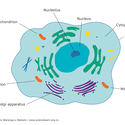Although we are all unique, there are often obvious similarities within families. Maybe you have the same nose as your brother or red hair like your mother? Family similarities occur because we inherit traits from our parents (in the form of the genes that contribute to the traits).
This passing of genes from one generation to the next is called heredity. Simple organisms pass on genes by duplicating their genetic information and then splitting to form an identical organism. More complex organisms, including humans, produce specialised sex cells (gametes) that carry half of the genetic information, then combine these to form new organisms. The process that produces gametes is called meiosis.
Meiosis makes sperm and eggs
During meiosis in humans, 1 diploid cell (with 46 chromosomes or 23 pairs) undergoes 2 cycles of cell division but only 1 round of DNA replication. The result is 4 haploid daughter cells known as gametes or egg and sperm cells (each with 23 chromosomes – 1 from each pair in the diploid cell).
At conception, an egg cell and a sperm cell combine to form a zygote (46 chromosomes or 23 pairs). This is the 1st cell of a new individual. The halving of the number of chromosomes in gametes ensures that zygotes have the same number of chromosomes from one generation to the next. This is critical for stable sexual reproduction through successive generations.
The phases of meiosis in humans
| Interphase | Replication of DNA in preparation for meiosis. After replication, each chromosome becomes a structure comprising 2 identical chromatids. |
| Prophase I | The chromosomes condense into visible X shaped structures that can be easily seen under a microscope, and homologous chromosomes pair up. Recombination occurs as homologous chromosomes exchange DNA. At the end of this phase, the nuclear membrane dissolves. |
| Metaphase I | Paired chromosomes line up along the middle of the cell. |
| Anaphase I | The pairs of chromosomes separate and move to opposing poles. Either one of each pair can go to either pole. |
| Telophase I | Nuclear membranes reform. Cell divides and 2 daughter cells are formed, each with 23 chromosomes. |
| Prophase II | There are now 2 cells. DNA does not replicate again. |
| Metaphase II | Individual chromosomes line up along the middle of the cell. |
| Anaphase II | The chromosome copies (chromatids) separate and move to opposing poles. |
| Telophase II | Nuclear membranes reform. There are 4 new haploid daughter cells. In males, 4 sperm cells are produced. In females, 1 egg cell and 3 polar bodies are produced. Polar bodies do not function as sex cells. |
Genetic variation is increased by meiosis
During fertilisation, 1 gamete from each parent combines to form a zygote. Because of recombination and independent assortment in meiosis, each gamete contains a different set of DNA. This produces a unique combination of genes in the resulting zygote.
Recombination or crossing over occurs during prophase I. Homologous chromosomes – 1 inherited from each parent – pair along their lengths, gene by gene. Breaks occur along the chromosomes, and they rejoin, trading some of their genes. The chromosomes now have genes in a unique combination.
Independent assortment is the process where the chromosomes move randomly to separate poles during meiosis. A gamete will end up with 23 chromosomes after meiosis, but independent assortment means that each gamete will have 1 of many different combinations of chromosomes.
This reshuffling of genes into unique combinations increases the genetic variation in a population and explains the variation we see between siblings with the same parents.
Useful link
Visit the Learn Genetics website to go on an animated tour of the basics. View the ‘What is inheritance?’ and ‘What is a trait’ segments to find out more about inheritance and variation.





